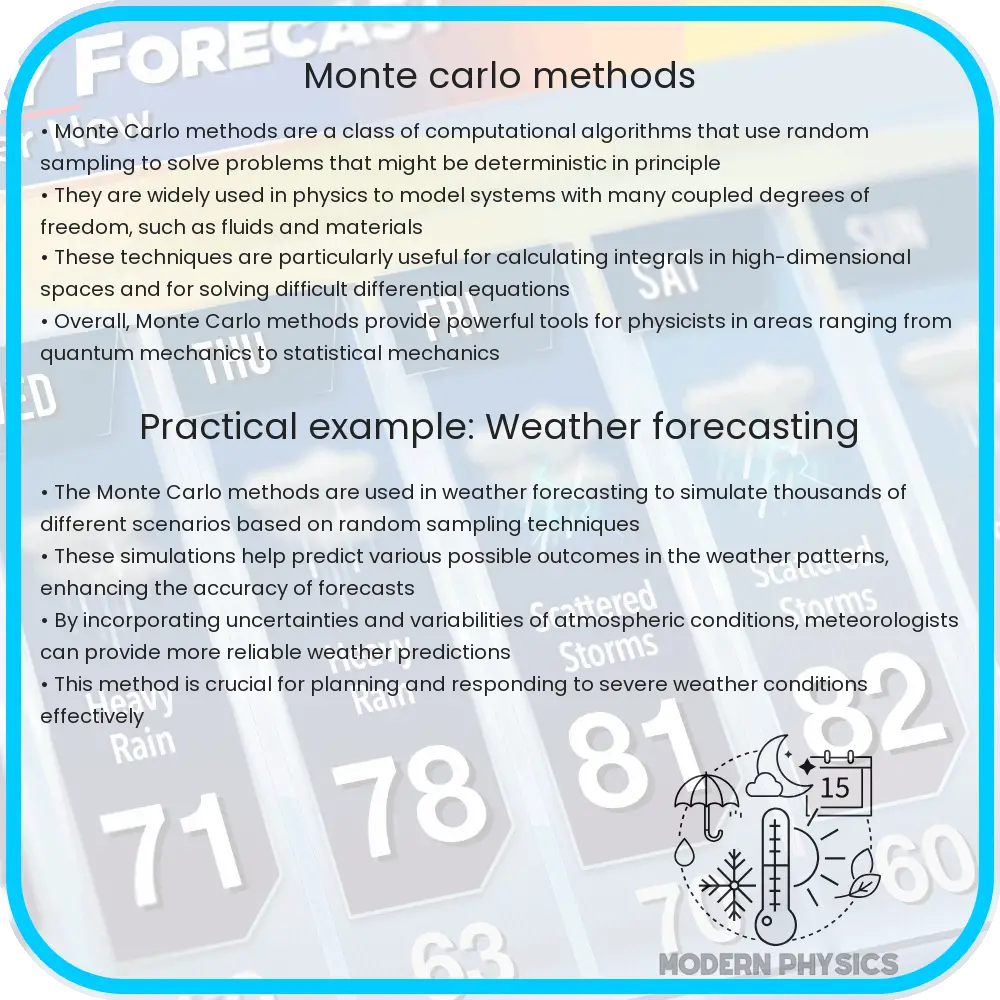Monte Carlo methods are computational algorithms using random sampling to solve problems numerically across various fields.

Introduction to Monte Carlo Methods
Monte Carlo methods are a broad class of computational algorithms that rely on repeated random sampling to obtain numerical results. The underlying concept is to solve a problem by simulating the process of random sampling, as this technique is especially useful in calculating quantities that are difficult to compute using deterministic algorithms. This makes Monte Carlo methods invaluable in various fields such as physics, finance, engineering, and even in gaming and graphics.
What Defines the Monte Carlo Method?
Monte Carlo methods are characterized by their use of randomness and repeated trials to achieve numerical results. The name ‘Monte Carlo’ was coined during the 1940s by scientists working on nuclear weapon projects in the United States, drawing inspiration from the Monte Carlo Casino in Monaco due to its association with chance and randomness.
Key Components of Monte Carlo Methods
The typical framework of a Monte Carlo simulation involves three key components:
- Random number generation: This is crucial as the quality of the random numbers affects the accuracy of the outcome. In simulations, pseudo-random number generators are usually employed.
- Statistical sampling: This is the process of selecting random samples from a probability distribution which represents the system being modeled.
- Estimation: Resulting data from the simulation are analyzed statistically to estimate the desired quantities.
Accuracy and Efficiency of Monte Carlo Simulations
The accuracy of Monte Carlo methods heavily depends on the laws of large numbers: the average result from many trials converges to the true value as more trials are performed. One common measure of accuracy for Monte Carlo simulations is the standard error, which decreases with the inverse square root of the number of iterations:
Standard Error ∝ 1 / sqrt(N)
where N is the number of independent random samples used in the simulation.
Efficiency in Monte Carlo methods can be viewed through their ability to decrease error with increasing sample size. Unlike deterministic numerical methods, which may need exponentially more computing power to reduce error substantially, Monte Carlo methods generally require a linear increase in computational effort for a linear decrease in error.
Modeling Real-World Systems with Monte Carlo
Monte Carlo simulations are particularly powerful in their ability to model complex systems and processes that are analytically intractable. Examples include simulating physical phenomena involving a large number of coupled degrees of freedom, such as fluid dynamics and molecular dynamics.
Each simulation can potentially include millions of variables that influence the final outcome, making the Monte Carlo method ideal for exploring scenarios in high-dimensional space. Techniques such as the Metropolis-Hastings algorithm are specifically designed for sampling from distributions that are difficult to handle directly, playing a critical role in modern computational statistics and physics.
Applications of Monte Carlo Methods in Various Fields
Monte Carlo methods have broad applications across various industries and disciplines, illustrating their versatility and power:
- Finance: In financial engineering, these methods are used to price and manage risk associated with complex derivatives and investment portfolios. They are particularly useful in scenarios where analytical solutions are difficult to obtain.
- Physics: In statistical physics, Monte Carlo methods are employed to study phase transitions and critical phenomena by simulating particle interactions on a large scale.
- Computer Graphics: These techniques are crucial in rendering visually realistic images by simulating the interaction of light with different surfaces.
- Operations Research: Monte Carlo simulations assist in network analysis and optimization, helping to predict system behavior in uncertain environments.
- Climate Science: They are also used in climate modeling to understand complex climate systems and to predict future climate changes.
Challenges and Solutions in Using Monte Carlo Simulations
Despite the efficacy of Monte Carlo methods, they come with certain challenges, namely computational cost and the quality of random number generators. Innovative solutions such as Variance Reduction Techniques (VRTs) like importance sampling and stratified sampling have been developed to increase efficiency and accuracy. Additionally, advancements in parallel computing allow for more complex simulations to be executed faster by distributing computations across multiple processors.
Conclusion
In summary, Monte Carlo methods are a dynamic and adaptable toolkit for solving a wide range of problems across different fields. These methods rely on the power of random sampling and statistical analysis to provide solutions where traditional approaches may falter. Whether it’s in finance, physics, or computer graphics, Monte Carlo simulations offer a valuable perspective by enabling detailed and sophisticated modeling of complex, stochastic systems. As technology progresses, the applications and efficiency of Monte Carlo methods will only expand, continuing to play a crucial role in scientific and engineering advancements.
